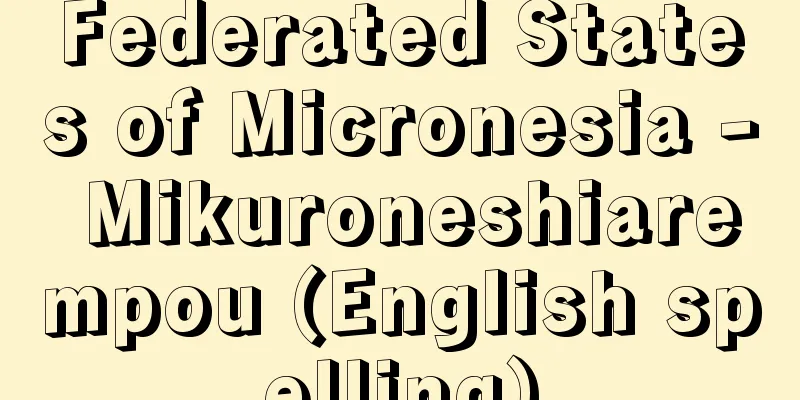Federated States of Micronesia - Mikuroneshiarempou (English spelling)

|
A federal state located in the Caroline Islands in the central Pacific Ocean. Its total land area is 702 square kilometers, but its 607 islands are all small, with the largest island being only 334 square kilometers. As a federation of islands scattered across the vast waters of Micronesia, each island has its own unique language and culture. Japanese was once the common language between the islands, but after Japan's defeat in World War II and the occupation by the American military, English has become the language of choice. It has a population of 120,000 (2002 estimate) and 110,728 (2009, World Bank), and gained independence in November 1986 from a United Nations Trust Territory under the administration of the United States. Its capital is Palikir, which was moved from Kolonia in November 1989. [Izumi Kobayashi] Nature and GeographyThe four states are Yap Islands, located 3,000 km from east to west, the central Chuuk Islands (formerly called Truk), Pohnpei Island (formerly called Ponape) to the east, and Kosrae Island (formerly called Kusai) at the eastern end. The main islands of each state except Yap Islands are volcanic islands with hills and mountains in the center, but Yap Islands is the only land island with ancient geology, and excavated pottery remains estimated to be from before Christ have been found, suggesting that human migration from Southeast Asia began around that time. However, in the daily lives of the people, although there was some exchange such as trade, there was no unity between the islands, and each region's language, lifestyle, and culture developed due to the differences in the island's form, vegetation, and climate. What further widened the differences between the islands were the individual historical developments that followed after contact with Westerners. For example, in the Chuuk Islands, which were heavily influenced by Japanese immigrants during the Japanese colonial period, more than 20% of the population are of Japanese descent, and the islands have produced several Japanese presidents and chiefs. In the Yap Islands, which have stubbornly maintained their island traditions, the structure of their traditional society remains. Similarly, on the island of Kosrae, the traditional structure unique to the island has disappeared, and the island has become home to many devout Christians. In forming a federal state, such heterogeneity is a diversity that enriches the nation, but it is also a source of instability that makes unification difficult. [Izumi Kobayashi] historyIn 1525, Portuguese explorers "discovered" the main island of Yap and Ulithi Atoll while exploring Indonesia. In 1529, the Spanish arrived on Pohnpei, and in 1565, they arrived on Chuuk, and the islands became known to Westerners. In 1595, Spain claimed Pohnpei, but had no real control over it. In the 19th century, whaling fleets, traders, and Protestant missionaries began to frequent the area near Pohnpei. Seeing this, Spain re-declared its control over the entire Caroline Islands and the Mariana Islands in 1886, and intensified Catholic missionary work in Pohnpei and sent troops to try to gain full control. At this time, Japanese people had already advanced to Pohnpei and Chuuk to trade copra (dried endosperm of the coconut palm). One of these people was Mori Koben (1869-1945), the great-grandfather of Emanuel Mori (1948-, in office 2007-), who became president in 2007. However, in 1899, after Spain's defeat in the Spanish-American War, it sold all of its territorial claims in Micronesia to Germany, with the exception of Guam in the Mariana Islands, which had been seized by the United States. Germany focused on copra production, but when World War I broke out in 1914, the entire Micronesian archipelago was occupied by Japan. Japan began governing the region, calling it the South Sea Islands, and in 1920 it was recognized as a mandated territory by the League of Nations. This led to the promotion of Japanization through Japanese language education for the local people and the construction of shrines, etc. At their peak in 1940, there were 8,048 Japanese people living in Pohnpei and 4,128 in Chuuk (Japanese living overseas), but few Japanese citizens traveled to Kosrae or Yap. During the Pacific War, the Japanese Navy established a Pacific Fleet base in the Chuuk Islands, but it was completely destroyed by thorough air raids by the US military. Over 60 warships remain submerged in the lagoon (the area of water inside the coral reef). After Japan's defeat in 1945, all Japanese nationals in the area were forcibly removed, and the islands came under American rule as a United Nations Trust Territory. While America eliminated all Japanese influence, it enthusiastically taught the local people English and instilled American-style democracy in the administration. Negotiations with the United States began in 1969 regarding the political status of the islands after the trusteeship ended. Initially, the Trust Territory of Micronesia was united in its policy of striving for self-governance or independence, but midway through negotiations with the United States, differences in the aims of each island group became apparent, leading to the secession of the Mariana Islands, the Marshall Islands, and the Palau Islands. As a result, the remaining four territories formed the Federated States of Micronesia, which achieved independence in 1986 in free association with the United States. [Izumi Kobayashi] PoliticsThe political system is a republic made up of four states. The Congress is unicameral, with one senator elected from each state to a four-year term and ten senators elected proportionally to the state's population to two-year terms, for a total of 14 members. The president and vice president are elected by vote from among the four-year term senators. States that have already produced a president and vice president hold supplementary elections to make up for the vacancies. The states have agreed to a rotation system to prevent the representatives from Chuuk State, which has a large number of representatives relative to the population, from monopolizing the presidency for consecutive years. In addition, there has been no political turmoil in the past, such as a vote of no confidence leading to the removal of the president from office. However, this is due to the fact that power is not concentrated in the president, rather than political stability. The central government led by the president is mainly responsible for foreign affairs, negotiations with the United States, and the distribution of government revenue to the states, and has no authority over state administration. In addition, the amount of financial aid from the United States, which is the basis of the country's finances, that each state government receives is determined by agreement. The central government does not have the authority to control the states, and the country is sometimes described as "a country with five governments." Each state has its own constitution, and is governed by a governor and a state legislature elected by direct election to four-year terms. The capital is Palikir on the island of Pohnpei, where lawmakers and bureaucrats from each state work, but even a quarter century after independence, the state barriers have not yet been removed. This is because there are no national corporations, and differences in the language and customs mean that there is little human interaction between the states. In international politics, Taiwan is actively seeking to expand its external relations, and as of 2012 it maintained diplomatic relations with 63 countries. Of the five Micronesian nations (Kiribati, Nauru, the Federated States of Micronesia, the Marshall Islands, and Palau), the other four all recognize Taiwan as a state, but the Federated States of Micronesia has established diplomatic relations with China and has an embassy in Beijing. [Izumi Kobayashi] Compact of Free Association"The Freely Associated States will have sovereignty under their constitution, but the United States will have full authority and responsibility for defense and security. At the same time, the United States will provide financial assistance for 15 years." This is the gist of the agreement that the three Micronesian nations (the Federated States of Micronesia, the Marshall Islands, and Palau) concluded with the United States. The economic agreement ended in 2001, but because the foundation for economic independence had not been established as planned, an agreement to continue financial assistance was concluded in 2004 for a limited period of 20 years. The name "Freely Associated" comes from the fact that either party can freely terminate the agreement at their request, and the agreement itself has no expiration date. Initially, there were concerns that a freely associated relationship with the United States would risk undermining independence. However, for a small nation without an army or its own currency, it has now become a prerequisite for the existence of the nation. [Izumi Kobayashi] Economy and SocietyThe country's finances are based on compact money from the United States. After independence, the country aimed to achieve economic independence within 15 years, but failed to achieve this, and was promised aid for another 20 years. The country has a mixture of a monetary economy and a traditional self-sufficient economy, but the source of funds for the monetary economy comes from the public sector and foreign aid, and domestic industries are extremely scarce. The government is trying to overcome this situation by developing the fishing and tourism industries. As the surrounding waters are good fishing grounds, fishing fees from foreign fishing boats exceed 20 million dollars per year, accounting for 30% of the national revenue. The government believes that if it can turn these fishing resources into a local industry, it will dramatically improve the economic structure. The GNI (gross national income) per capita is $2,220 (2009). Despite the lack of industry, this level has been maintained due to financial aid as well as the large contribution of remittances from people who have left the country. There are few jobs within the country. However, as the country has free association with the United States, people are free to travel to and from the United States, including for work, and the official language is English, so there is little resistance to going to the United States. These conditions are encouraging young people to emigrate overseas. The currency is the US dollar. English is the official and common language, with local languages such as Chuukese, Yapese, and Kosraean also being used. Religion is mostly Christian Catholicism and Protestantism, but local traditional beliefs remain strong. The education system consists of eight years of primary education and four years of secondary education, and the language of instruction is English. 90% of the population graduates from primary school. The country's higher education institution is the College of Micronesia in the state of Pohnpei, where the capital is located, which offers liberal arts education and teacher training. Those seeking a full-fledged university education can obtain scholarships to attend universities in Guam, Hawaii, or the US mainland. The rate of enrollment in higher education for the population is just under 20%. [Izumi Kobayashi] Relations with JapanMany years have passed since the Pacific War, and the number of Japanese-speaking generations has dwindled, but the people of the Federated States of Micronesia remain very pro-Japan. The Federated States of Micronesia opened a Tokyo office in 1984 (Showa 59) during its autonomous government era, and upgraded it to an embassy when diplomatic relations were established in 1988 (Showa 63). Japan also opened a diplomatic mission on Pohnpei in 1995 (Heisei 7), and upgraded it to an embassy with a resident ambassador in 2008 (Heisei 20). As of 2011, construction work to extend the runway at Pohnpei Airport is underway with assistance from Japan, and when completed, direct flights from Japan will be possible. Cumulative ODA (Official Development Assistance) provided to the country up to 2009 was 25.564 billion yen. [Izumi Kobayashi] "Living in Micronesia" by Yasaka Yumi (2000, Akashi Shoten) " "I Was a Teacher on a Southern Island" by Okuno Ayumu (2004, Shounsha) " "Japanese on Southern Islands" by Kobayashi Izumi (2010, Sankei Shimbun Publishing) [References] | | | | | | | | | [Supplementary information] |"> Flag of the Federated States of Micronesia ©Shogakukan Illustration/Shogakukan Creative "> Location map of the Federated States of Micronesia Source: Shogakukan Encyclopedia Nipponica About Encyclopedia Nipponica Information | Legend |
|
中部太平洋のカロリン諸島に位置する連邦国家。全体の陸地面積は702平方キロメートルであるが、607を数える島はどれも小さく国内最大のポンペイ島でも334平方キロメートルである。ミクロネシアの広範な海域に散在する複数諸島の連合体だけに、島々には独自の言語や文化が形成されている。かつて異島間の共通語は日本語であったが、第二次世界大戦での日本の敗戦、アメリカ軍の占領以後は英語が使用されている。人口12万(2002年推計)、11万0728(2009年、世界銀行)で、1986年11月にアメリカ施政下の国連信託統治領から独立した。首都はパリキールで、1989年11月にコロニアから遷都した。 [小林 泉] 自然・地誌東西3000キロメートルの最西端にあるヤップ諸島、中央のチューク諸島(旧称トラック)、その東のポンペイ島(旧称ポナペ)、最東端のコスラエ島(旧称クサイ)で4州を構成している。ヤップ諸島以外の各州の本島となる島は中央部に丘陵や山岳を有する火山島だが、ヤップ諸島だけが古い地質の陸島で、紀元前と推定される土器遺跡なども発掘されており、東南アジア方面からの人類移動がそのころから始まっていたことを思わせる。しかし、日常の人々の暮らしでは、交易などの多少の交流があったにせよ諸島間の一体性はなく、それぞれの島嶼(とうしょ)形態や植生、気候風土の違いにより地域ごとの言語や生活習慣・文化が発展した。 諸島間の違いをいっそう広げたのは、西洋人との接触後にたどった歴史的展開の個別性であった。たとえば、日本統治時代の日本人移住者の影響の強いチューク諸島では、住民の2割以上が日系人となり、日系人大統領や日系人酋長を複数輩出する諸島になった。島の伝統をかたくなに守り続けたヤップ諸島では伝統社会の構造が残っている。また、コスラエ島では島特有の伝統構造が消え、敬虔(けいけん)なキリスト教信仰者の多い島になった。連邦国家を形成するうえで、こうした異質性は国家を豊かにする多様性でもあるが、統一を難しくする不安定要因にもなっている。 [小林 泉] 歴史1525年、ポルトガルの探検家がインドネシア探索中にヤップ本島とウルシー環礁を「発見」、1529年にはスペイン人がポンペイ島に、1565年にはチューク島に寄港して、島々は西洋人の知るところとなった。1595年、スペインがポンペイ島の領有権を宣言したが実質的な統治はなかった。19世紀に入るとポンペイ島近辺には捕鯨船団や貿易商、プロテスタント宣教師らが頻繁に行き交うようになり、これを見たスペインは1886年、カロリン諸島全体とマリアナ諸島まで含めた地域の領有権を再宣言し、ポンペイを中心にキリスト教カトリック布教を活発化させ、軍隊も送って本格統治を試みた。この時期すでに、日本からもコプラ(ココヤシの果実の胚乳を乾燥させたもの)貿易のためにポンペイ島、チューク諸島に進出していた日本人がいた。2007年に大統領に就任したイマニュエル・モリEmanuel Mori(1948― 、在任2007~ )の曽祖父である森小弁(もりこべん)(1869―1945)は、そのなかの一人である。 しかし1899年、米西戦争に敗れたスペインは、アメリカに奪われたマリアナ諸島のグアムを除き、すべてのミクロネシア領有権をドイツに売却。ドイツはコプラ生産に力を注いだが、1914年に第一次世界大戦が勃発(ぼっぱつ)するとミクロネシア全島は日本に占領された。日本はこの地域を南洋群島と称して統治を始め、1920年には国際連盟の委任統治領に認められた。 これにより現地民への日本語教育や神社の建立などの日本化を進めた。ポンペイには最盛期の1940年時点で8048人、チュークには4128人の邦人(海外居住日本人)が居住したが、コスラエやヤップへと渡る民間邦人は少なかった。 太平洋戦争時、日本海軍はチューク諸島に太平洋艦隊基地を置いたが、アメリカ軍の徹底空爆を受け全滅した。ラグーン(サンゴ礁内の海域・礁湖)には60余隻の艦艇がいまも沈んでいる。1945年の日本の敗戦で、域内の邦人はすべて強制退去させられ、島々は国際連合信託統治領としてアメリカの統治下に入った。アメリカは、日本的影響をことごとく排除する一方、地元民に英語を身につけさせ、アメリカ式民主主義を植えつける行政を熱心に行った。 信託統治終了後の島々の政治地位について、アメリカとの交渉が始まったのが1969年である。当初、信託統治領ミクロネシアは一丸となって自治または独立を目ざす方針を立てていたが、アメリカとの交渉途中で、諸島ごとの思惑の違いが顕在化。それがマリアナ諸島、マーシャル諸島、パラオ諸島の離脱につながった。その結果、残った4地区をもってミクロネシア連邦を形成し、1986年にアメリカとの自由連合関係の下に独立を果たしたのである。 [小林 泉] 政治政体は4州で連邦を構成する共和制。議会は一院制で、各州から1人選出される4年任期議員と州の人口比例で選出される2年任期議員10名の計14名で構成される。正副大統領は4年任期議員のなかから、議員による投票で選出される。正副大統領を出した州は、補充選挙を実施して不足を補う。 人口比により議員数の多いチューク州選出議員が連続して大統領職を独占しないように各州輪番制合意ができている。また、過去には不信任などで大統領職を追われるような政治混乱もなかった。だが、これは政治の安定というより、大統領にさほどの権限が集中していないことによる。大統領が率いる中央政府は、外交や対米交渉、政府収入の各州分配に関する業務が主で、州内行政への権限を有しないからである。また、財政の根幹となすアメリカからの財政援助金も協定で各州政府の受領額が決まっている。中央政府に州をコントロールする権限はなく、「五つの政府がある国」と表現されたりする。各州は独自の憲法を有し、直接選挙で選出される4年任期の知事と州議会の下で統治されている。 首都はポンペイ島のパリキールに置かれ、各州から集まった議員や官僚が働いているが、独立後四半世紀が過ぎても依然として一国家のなかで州の壁が取り除かれていない。それは国家的な企業等がないことや使用言語、習慣の違いから、各州間の人的交流が進まないからである。 国際政治では、積極的に対外関係の拡大を図ろうとしており、2012年時点で63か国との外交関係を維持している。ミクロネシア5か国(キリバス、ナウル、ミクロネシア連邦、マーシャル諸島、パラオ)のなかで、他の4か国がいずれも台湾を国家承認しているが、ミクロネシア連邦は中国と外交関係を結んで北京に大使館を設置している。 [小林 泉] 自由連合協定Compact of Free Association「自由連合国は、憲法の下に主権を有するが、防衛と安全保障についてはアメリカが全面的権限と責任を負う。同時に、アメリカは15年間にわたり財政支援を行う」。これが、ミクロネシア三国(ミクロネシア連邦、マーシャル諸島、パラオ)がアメリカと結んだ協定の骨子である。経済協定は2001年で終了したが、計画通りに経済自立への基盤が整わなかったため、2004年から20年間に限り財政支援の継続協定が結ばれた。「自由連合」の名称由来は、どちらか一方の申し出で自由に協定の解消ができるところから来ており、協定自体に有効期限はない。当初、アメリカとの自由連合関係は独立性を損ねる危険があるとの懸念もあった。しかし、軍隊も自国通貨ももたない小国にとって、いまでは国家存立の前提になっている。 [小林 泉] 経済・社会財政は、アメリカからの協定援助金(コンパクトマネー)を基本に成り立っている。独立後15年間で経済自立の達成を目ざしたが実現できず、さらに20年間の援助が約束された。貨幣経済と伝統的自給経済が混在するが、貨幣経済の原資は公的部門や外国援助から発生するもので、域内産業はきわめて乏しい。政府はこうした現状を、漁業や観光業の開発で打開しようとしている。周辺海域が好漁場のため外国漁船からの入漁料収入は年間2000万ドル超、国家歳入の30%にものぼる。政府はこれだけの漁業資源を自ら地場産業化すれば、一気に経済構造が好転すると考えている。 国民1人当りのGNI(国民総所得)は2220ドル(2009)。産業のないわりにこの水準を保てるのは、財政援助のほかにも国外に出た人たちからの送金が大きく貢献しているからである。国内には仕事が少ない。しかし、自由連合関係は、就労を含めてアメリカへの出入りが自由であり、公用語も英語だからアメリカ行きにあまり抵抗がない。こうした条件が若者の海外転出傾向を後押ししている。通貨はアメリカ・ドル。 言語は英語が公用語で共通言語として使われており、地域ごとにチューク語、ヤップ語、コスラエ語などの言語も使われている。宗教はキリスト教のカトリック、プロテスタントが多いが地域伝統信仰も色濃く残っている。 教育制度は初等教育が8年、中等教育が4年で、教育言語は英語。国民の90%が小学校を卒業する。国内の高等教育機関としては、首都のあるポンペイ州にミクロネシア短期大学があり、教養教育や教員養成などを行っている。本格的な大学教育を求める者は、奨学金を得てグアムやハワイ、アメリカ本土の大学に進学する。国民の高等教育への進学率は20%弱。 [小林 泉] 日本との関係太平洋戦争後長い年月が経過し、日本語を話す世代は少なくなったが、ミクロネシア連邦住民の親日度は依然として高い。自治政府時代の1984年(昭和59)には東京事務所を開設し、1988年(昭和63)の外交関係樹立とともに大使館に昇格させるなど、日本との関係を重視している。日本も1995年(平成7)にポンペイ島に公館を開設し、2008年(平成20)には大使が常駐する大使館に昇格させた。 2011年時点で、日本の援助によるポンペイ空港の滑走路延長工事が進められているが、これが完成すれば日本からの直行便就航が可能となる。2009年までの累積ODA(政府開発援助)供与は255.64億円である。 [小林 泉] 『八坂由美著『ミクロネシアで暮らす』(2000・明石書店)』▽『奥野歩著『わたし、南の島で先生しました』(2004・翔雲社)』▽『小林泉著『南の島の日本人』(2010・産経新聞出版)』 [参照項目] | | | | | | | | | [補完資料] |"> ミクロネシア連邦の国旗 ©Shogakukan 作図/小学館クリエイティブ"> ミクロネシア連邦位置図 出典 小学館 日本大百科全書(ニッポニカ)日本大百科全書(ニッポニカ)について 情報 | 凡例 |
>>: Micronesian - Micronesian (English spelling)
Recommend
Pyrenean mountain dog [breed] (English spelling)
A herding dog and domestic dog originating from Sp...
Gishiwajinden - Records of the Wa
One of the official histories of ancient Japan in ...
Secrets of official positions - Kanshoku Hisho
A book in two volumes detailing the standards and ...
Ogham
…It is one of the Indo-European languages curre...
Saussurea tanakae (English spelling)
…[Mitsuru Hotta] [Aya Nitta]. … *Some of the term...
Uruatri
…At its height, it occupied the entire Armenian P...
Ankaran - Ankaran
...They also share many cultural, social and econ...
Stanhope, C.
…With the invention of this machine, the pressure...
Ilion (English spelling)
A town in central New York State, United States. I...
Naumburger Meister (English spelling)
…The interior of the church contains the reliefs ...
Buyeo
A county in the southwest of Chungcheongnam-do, Ko...
Ensemble area - Ensemble
...In addition to kimono length, rolls of cloth i...
Miami Beach
A resort and tourist city in southeastern Florida,...
Flower Festival
A Kagura festival held in each village in the luna...
Bengbu - Bengbu
A prefecture-level city in the northern part of A...









